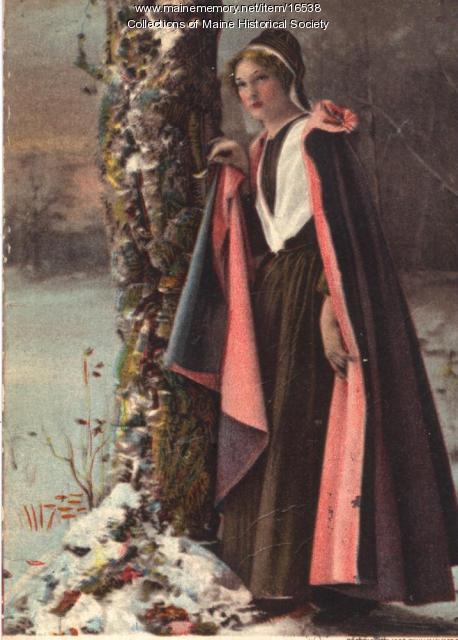Keywords: The Acadia
- Historical Items (214)
- Tax Records (0)
- Architecture & Landscape (1)
- Online Exhibits (10)
- Site Pages (89)
- My Maine Stories (2)
- Lesson Plans (3)
Lesson Plans
Your results include these lesson plans. Your results include these lesson plans.
Lesson Plan
Maine's Acadian Community: "Evangeline," Le Grand Dérangement, and Cultural Survival
Grade Level: 9-12
Content Area: English Language Arts, Social Studies
This lesson plan will introduce students to the history of the forced expulsion of thousands of people from Acadia, the Romantic look back at the tragedy in Henry Wadsworth Longfellow's famous epic poem Evangeline and the heroine's adoption as an Acadian cultural figure, and Maine's Acadian community today, along with their relations with Acadian New Brunswick and Nova Scotia residents and others in the Acadian Diaspora. Students will read and discuss primary documents, compare and contrast Le Grand Dérangement to other forced expulsions in Maine history and discuss the significance of cultural survival amidst hardships brought on by treaties, wars, and legislation.
Lesson Plan
Longfellow Studies: The Acadian Diaspora - Reading "Evangeline" as a Feminist and Metaphoric Text
Grade Level: 6-8, 9-12
Content Area: English Language Arts, Social Studies
Evangeline, Longfellow's heroine, has long been read as a search for Evangeline's long-lost love, Gabrielle--separated by the British in 1755 at the time of the Grand Derangement, the Acadian Diaspora. The couple comes to find each other late in life and the story ends. Or does it?
Why does Longfellow choose to tell the story of this cultural group with a woman as the protagonist who is a member of a minority culture the Acadians? Does this say something about Longfellow's ability for understanding the misfortunes of others?
Who is Evangeline searching for? Is it Gabriel, or her long-lost land of Acadia? Does the couple represent that which is lost to them, the land of their birth and rebirth? These are some of the thoughts and ideas which permeate Longfellow's text, Evangeline, beyond the tale of two lovers lost to one another. As the documentary, Evangeline's Quest (see below) states: "The Acadians, the only people to celebrate their defeat." They, as a cultural group, are found in the poem and their story is told.
Lesson Plan
Longfellow Studies: "Evangeline: A Tale of Acadie"--Selected Lines and Illustrations
Grade Level: 6-8, 9-12
Content Area: Social Studies, Visual & Performing Arts
Henry Wadsworth Longfellow, Maine's native son, is the epitome of Victorian Romanticism. Aroostook County is well acquainted with Longfellow's epic poem, Evangeline, because it is the story of the plight of the Acadians, who were deported from Acadie between 1755 and 1760. The descendants of these hard-working people inhabit much of Maine, New Brunswick, and Nova Scotia.
The students enjoy hearing the story and seeing the ink drawings. The illustrations are my interpretations. The collection took approximately two months to complete. The illustrations are presented in a Victorian-style folio, reminiscent of the family gathered in the parlor for a Sunday afternoon reading of Evangeline, which was published in 1847.
Preparation Required/Preliminary Discussion:
Have students read "Evangeline A Tale of Acadie". Give a background of the Acadia Diaspora.
Suggested Follow-up Activities:
Students could illustrate their own poems, as well as other Longfellow poems, such as: "Paul Revere's Ride," "The Village Blacksmith," or "The Children's Hour."
"Tales of the Wayside Inn" is a colonial Canterbury Tales. The guest of the inn each tell stories. Student could write or illustrate their own characters or stories.
Appropriate calligraphy assignments could include short poems and captions for their illustrations. Inks, pastels, watercolors, and colored pencils would be other appropriate illustrative media that could be applicable to other illustrated poems and stories. Each illustration in this exhibit was made in India ink on file folder paper. The dimensions, including the burgundy-colors mat, are 9" x 12". A friend made the calligraphy.




